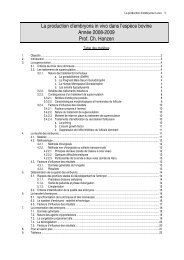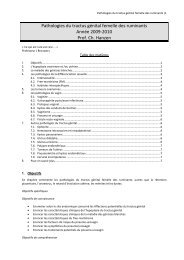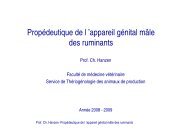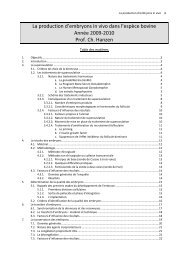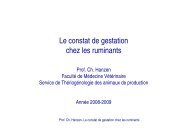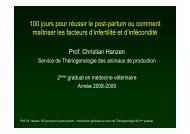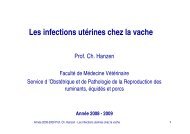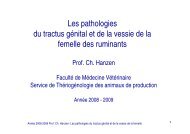Les interventions obstétricales chez les ruminants - Thériogénologie ...
Les interventions obstétricales chez les ruminants - Thériogénologie ...
Les interventions obstétricales chez les ruminants - Thériogénologie ...
- No tags were found...
Create successful ePaper yourself
Turn your PDF publications into a flip-book with our unique Google optimized e-Paper software.
<strong>Les</strong> <strong>interventions</strong> obstétrica<strong>les</strong><strong>chez</strong> <strong>les</strong> <strong>ruminants</strong>Prof. Ch. HanzenFaculté de médecine vétérinaireService de Thériogénologie des animaux de productionCours de 2ème GMVAnnée 2008 - 2009Année 2008-2009 Prof. Ch. Hanzen <strong>Les</strong> <strong>interventions</strong> obstétrica<strong>les</strong> <strong>chez</strong> <strong>les</strong> <strong>ruminants</strong>
Références Derivaux J., Ectors F. Physiopathologie de la gestation et Obstétriquevétérinaire. Editions du Point Vétérinaire, 1980 Jackson PGG. Handbook of Veterinary Obstetrics, 2nd Edition, 2004.Saunders Ltd. ISBN:0702027405. Jones T. Complete foaling manual. Ed. Equine research, 1996Année 2008-2009 Prof. Ch. Hanzen <strong>Les</strong> <strong>interventions</strong> obstétrica<strong>les</strong> <strong>chez</strong> <strong>les</strong> <strong>ruminants</strong>
Objectif généralCe chapitre a pour objectif de décrire <strong>les</strong> manipulations nonsanglantes (traction, propulsion, version, rotation) et sanglantes(épisiotomie, césarienne, embryotomie) nécessitées selon <strong>les</strong> cas dedystocies rencontrées.Il précise la nature et <strong>les</strong> conditions d’utilisation du matérielnécessaire à ces diverses <strong>interventions</strong>.Il présente <strong>les</strong> indications des diverses manipulations sanglantes ounon à mettre en place lors de dystocies.Année 2008-2009 Prof. Ch. Hanzen <strong>Les</strong> <strong>interventions</strong> obstétrica<strong>les</strong> <strong>chez</strong> <strong>les</strong> <strong>ruminants</strong>
Objectifs spécifiques de connaissanceDécrire le matériel nécessaire à la traction et son utilisationDéfinir la propulsionDéfinir rotation et versionCiter <strong>les</strong> particularités de la traction <strong>chez</strong> <strong>les</strong> petits <strong>ruminants</strong>Enoncer <strong>les</strong> indications de l'épisiotomie et en décrire la réalisationEnoncer <strong>les</strong> indications de la césarienneEnoncer <strong>les</strong> situations preopératoires à risqueEnoncer le matériel chirurgical et pharmacologique nécessaire à la réalisationd’une césarienne.Enoncer <strong>les</strong> divers sites opératoires possib<strong>les</strong> de la césarienne et leurs indications.Enoncer de manière chronologique <strong>les</strong> divers temps opératoires d’une césarienneréalisée <strong>chez</strong> la vache en position debout dans le flanc gaucheAnnée 2008-2009 Prof. Ch. Hanzen <strong>Les</strong> <strong>interventions</strong> obstétrica<strong>les</strong> <strong>chez</strong> <strong>les</strong> <strong>ruminants</strong>
Objectifs spécifiques de connaissance (suite)Enoncer <strong>les</strong> particularités de la césarienne dans le flanc droit et sur la vachecouchéeEnoncer <strong>les</strong> accidents et incidents peropératoiresDécriire l'évolution normale de l'état général de la vache et du veau après unecésarienneDécrire <strong>les</strong> soins postopératoires habituels à la mère et au veauEnoncer <strong>les</strong> complications postopératoires de la césarienneEnoncer <strong>les</strong> indications et particularités de la césarienne <strong>chez</strong> <strong>les</strong> petits <strong>ruminants</strong>Définir l’embryotomieEnoncer <strong>les</strong> indications de l'embryotomieDécrire le matériel nécessaire à la réalisation d’une embryotomie transcutanéeEnoncer <strong>les</strong> précautions généra<strong>les</strong> à prendre lors d'embryotomieCitez <strong>les</strong> vérifications à faire après une embrytomie <strong>chez</strong> la vacheAnnée 2008-2009 Prof. Ch. Hanzen <strong>Les</strong> <strong>interventions</strong> obstétrica<strong>les</strong> <strong>chez</strong> <strong>les</strong> <strong>ruminants</strong>
Objectifs spécifiques de compréhensionExpliquer <strong>les</strong> étapes et conditions d'une traction en présentationantérieure et postérieureExpliquer <strong>les</strong> conditions de réalisation et <strong>les</strong> champs d'application dela propulsionExpliquer <strong>les</strong> précautions à mettre en œuvre face aux situations àrisqueEn fonction du mode opératoire choisi, expliquer <strong>les</strong> différentesétapes de la préparation à l'interventionCommenter le choix d'un site opératoire de la césarienneExpliquer <strong>les</strong> conduites à tenir lors des accidents et incidentsperopératoires <strong>les</strong> plus fréquentsjustifier <strong>les</strong> précautions généra<strong>les</strong> avant d'entreprendre et en coursd'embryotomieAnnée 2008-2009 Prof. Ch. Hanzen <strong>Les</strong> <strong>interventions</strong> obstétrica<strong>les</strong> <strong>chez</strong> <strong>les</strong> <strong>ruminants</strong>
Objectifs spécifiques d’applicationsavoir mettre en place des lacs sur un membre ou la tête en vued'une tractionInformer l'éleveur des soins à donner à la vache et à son veauInformer l'éleveur des signes d'alerte d'une complication éventuelleSavoir monter et mettre en place un embryotome à scie-filAu moyen d'un schéma décrire la mise en place de l'embryotomepour une section donnéeAnnée 2008-2009 Prof. Ch. Hanzen <strong>Les</strong> <strong>interventions</strong> obstétrica<strong>les</strong> <strong>chez</strong> <strong>les</strong> <strong>ruminants</strong>
<strong>Les</strong> <strong>interventions</strong> obstétrica<strong>les</strong>- Interventions non sanglantesTractionPropulsionRotationVersion- Interventions sanglantesCésarienneEmbryotomieEpisiotomieAnnée 2008-2009 Prof. Ch. Hanzen <strong>Les</strong> <strong>interventions</strong> obstétrica<strong>les</strong> <strong>chez</strong> <strong>les</strong> <strong>ruminants</strong>
<strong>Les</strong> manipulations non-sanglantesAnnée 2008-2009 Prof. Ch. Hanzen <strong>Les</strong> <strong>interventions</strong> obstétrica<strong>les</strong> <strong>chez</strong> <strong>les</strong> <strong>ruminants</strong>
La traction Placement des lacs ou chaînes Placement de lacs (ou chaînes) sur la tête (1) et <strong>les</strong> membres (2)• (1) inutile si la tête est dans la filière pelvienne• (2) application au-dessus des boulets Fixation des lacs sur le manche de traction (25 à 30 cm de corde) Utilisation d ’une vêleuse : expérience nécessaire Force d ’expulsion d ’une vache : 75 kgs Force de traction de deux hommes : 200 kgs Force de traction d ’une vêleuse : 400 kgs ?????Année 2008-2009 Prof. Ch. Hanzen <strong>Les</strong> <strong>interventions</strong> obstétrica<strong>les</strong> <strong>chez</strong> <strong>les</strong> <strong>ruminants</strong>
Espèce bovine : Mise en place des lacsAnnée 2008-2009 Prof. Ch. Hanzen <strong>Les</strong> <strong>interventions</strong> obstétrica<strong>les</strong> <strong>chez</strong> <strong>les</strong> <strong>ruminants</strong>
Traction sur la tête du foetus : méthodesLicol arrêté par unnœud coulant simpleLicol deDelafoy(torsadé)Licol deJobert(arrêté parun anneau)Licol à têtière etmuserole(anse double)Licol avec ansedans la boucheAnnée 2008-2009 Prof. Ch. Hanzen <strong>Les</strong> <strong>interventions</strong> obstétrica<strong>les</strong> <strong>chez</strong> <strong>les</strong> <strong>ruminants</strong>
Placement d’un lac de tête (Schmitt D et De meijer F CD editions Med ‘Com)Année 2008-2009 Prof. Ch. Hanzen <strong>Les</strong> <strong>interventions</strong> obstétrica<strong>les</strong> <strong>chez</strong> <strong>les</strong> <strong>ruminants</strong>
Année 2008-2009 Prof. Ch. Hanzen <strong>Les</strong> <strong>interventions</strong> obstétrica<strong>les</strong> <strong>chez</strong> <strong>les</strong> <strong>ruminants</strong>
Espèce bovine : Fixation des lacs de tractionAnnée 2008-2009 Prof. Ch. Hanzen <strong>Les</strong> <strong>interventions</strong> obstétrica<strong>les</strong> <strong>chez</strong> <strong>les</strong> <strong>ruminants</strong>
Année 2008-2009 Prof. Ch. Hanzen <strong>Les</strong> <strong>interventions</strong> obstétrica<strong>les</strong> <strong>chez</strong> <strong>les</strong> <strong>ruminants</strong>
Année 2008-2009 Prof. Ch. Hanzen <strong>Les</strong> <strong>interventions</strong> obstétrica<strong>les</strong> <strong>chez</strong> <strong>les</strong> <strong>ruminants</strong>
Année 2008-2009 Prof. Ch. Hanzen <strong>Les</strong> <strong>interventions</strong> obstétrica<strong>les</strong> <strong>chez</strong> <strong>les</strong> <strong>ruminants</strong>Espèce bovine :Traction vers le basDégagement de la tête
Année 2008-2009 Prof. Ch. Hanzen <strong>Les</strong> <strong>interventions</strong> obstétrica<strong>les</strong> <strong>chez</strong> <strong>les</strong> <strong>ruminants</strong>Espèce bovine :Accouchement aumoyen d ’une vêleuse
Lors de la traction : compression possible du cordon par le fœtusHPCCVCNBVOVl cordon / L foetus2/11/12/31/31/41/6Année 2008-2009 Prof. Ch. Hanzen <strong>Les</strong> <strong>interventions</strong> obstétrica<strong>les</strong> <strong>chez</strong> <strong>les</strong> <strong>ruminants</strong>
La traction en présentation antérieure Sens de la traction Vers le haut pour faire franchir le détroit antérieur à la tête Horizontalement ensuite Vers <strong>les</strong> jarrets de la vache en fin de traction Méthodologie de la traction Alterner la traction sur <strong>les</strong> membres et la tête Eviter des tractions fortes pendant plus de 10 minutes Faire coïncider <strong>les</strong> tractions avec <strong>les</strong> efforts expulsifs de la mère Une fois la vulve franchie: traction simultanée sur <strong>les</strong> membres et la tête Point de résistance : passage du thorax dans le détroit antérieur cad enfait quand la tête arrive au niveau du vagin postérieur et de la vulveAnnée 2008-2009 Prof. Ch. Hanzen <strong>Les</strong> <strong>interventions</strong> obstétrica<strong>les</strong> <strong>chez</strong> <strong>les</strong> <strong>ruminants</strong>
Année 2008-2009 Prof. Ch. Hanzen <strong>Les</strong> <strong>interventions</strong> obstétrica<strong>les</strong> <strong>chez</strong> <strong>les</strong> <strong>ruminants</strong>
Année 2008-2009 Prof. Ch. Hanzen <strong>Les</strong> <strong>interventions</strong> obstétrica<strong>les</strong> <strong>chez</strong> <strong>les</strong> <strong>ruminants</strong>
Année 2008-2009 Prof. Ch. Hanzen <strong>Les</strong> <strong>interventions</strong> obstétrica<strong>les</strong> <strong>chez</strong> <strong>les</strong> <strong>ruminants</strong>
Année 2008-2009 Prof. Ch. Hanzen <strong>Les</strong> <strong>interventions</strong> obstétrica<strong>les</strong> <strong>chez</strong> <strong>les</strong> <strong>ruminants</strong>
La traction en présentation postérieure Risque accru / présentation antérieure : rupture prématurée du cordon Sens de la traction : idem présentation antérieure Méthodologie de la traction : Alterner la traction sur <strong>les</strong> membres Traction sur <strong>les</strong> deux membres une fois franchi le détroit antérieur Augmenter à ce moment la force de traction pour accélérer le processus Abandon si pas de progression du fœtus après 10 minutesAnnée 2008-2009 Prof. Ch. Hanzen <strong>Les</strong> <strong>interventions</strong> obstétrica<strong>les</strong> <strong>chez</strong> <strong>les</strong> <strong>ruminants</strong>
Aide lors de l ’accouchement <strong>chez</strong> la vacheAnnée 2008-2009 Prof. Ch. Hanzen <strong>Les</strong> <strong>interventions</strong> obstétrica<strong>les</strong> <strong>chez</strong> <strong>les</strong> <strong>ruminants</strong>
Fracture de la mâchoire inférieure <strong>chez</strong> le veauAnnée 2008-2009 Prof. Ch. Hanzen <strong>Les</strong> <strong>interventions</strong> obstétrica<strong>les</strong> <strong>chez</strong> <strong>les</strong> <strong>ruminants</strong>
Contracture des membres antérieursAnnée 2008-2009 Prof. Ch. Hanzen <strong>Les</strong> <strong>interventions</strong> obstétrica<strong>les</strong> <strong>chez</strong> <strong>les</strong> <strong>ruminants</strong>
Transport du veau après la naissanceAnnée 2008-2009 Prof. Ch. Hanzen <strong>Les</strong> <strong>interventions</strong> obstétrica<strong>les</strong> <strong>chez</strong> <strong>les</strong> <strong>ruminants</strong>
Année 2008-2009 Prof. Ch. Hanzen <strong>Les</strong> <strong>interventions</strong> obstétrica<strong>les</strong> <strong>chez</strong> <strong>les</strong> <strong>ruminants</strong>
La propulsion (ou rétropulsion) Définition refoulement dans la cavité utérine du foetus ou de ses parties Procédure animal en position debout épidurale pour réduire <strong>les</strong> efforts expulsifs à la main ou avec des repoussoirs bonne lubrification des voies génita<strong>les</strong> placer des lacs sur <strong>les</strong> membres Applications : corrections de présentations ou positions anorma<strong>les</strong>Année 2008-2009 Prof. Ch. Hanzen <strong>Les</strong> <strong>interventions</strong> obstétrica<strong>les</strong> <strong>chez</strong> <strong>les</strong> <strong>ruminants</strong>
La rotation Définition application au fœtus d ’un mouvement de révolution sur son axelongitudinal pour le placer en position dorso ou lombo-sacrée Procédure manœuvre toujours précédée de la propulsion animal en position debout épidurale pour réduire <strong>les</strong> efforts expulsifs à la main avec éventuellement un bâton fixé entre <strong>les</strong> membres bonne lubrification des voies génita<strong>les</strong> Applications : corrections de présentations ou positions anorma<strong>les</strong>Année 2008-2009 Prof. Ch. Hanzen <strong>Les</strong> <strong>interventions</strong> obstétrica<strong>les</strong> <strong>chez</strong> <strong>les</strong> <strong>ruminants</strong>
La version Définition manœuvre ayant pour but de changer la présentation du fœtus. Elleréalisée sur le fœtus entier ou après embryotomie partielle Version céphalique : changement d ’une présentation transversale enprésentation antérieure Version pelvienne : changement d ’une présentation transversale enprésentation postérieure Procédure manœuvre impliquant un refoulement et une traction debout épidurale pour réduire <strong>les</strong> efforts expulsifs Applications : corrections de présentation transversaleAnnée 2008-2009 Prof. Ch. Hanzen <strong>Les</strong> <strong>interventions</strong> obstétrica<strong>les</strong> <strong>chez</strong> <strong>les</strong> <strong>ruminants</strong>
<strong>Les</strong> manipulations obstétrica<strong>les</strong> non sanglantes<strong>chez</strong> <strong>les</strong> petits <strong>ruminants</strong>Année 2008-2009 Prof. Ch. Hanzen <strong>Les</strong> <strong>interventions</strong> obstétrica<strong>les</strong> <strong>chez</strong> <strong>les</strong> <strong>ruminants</strong>
Espèce ovine : Examen vaginalAnnée 2008-2009 Prof. Ch. Hanzen <strong>Les</strong> <strong>interventions</strong> obstétrica<strong>les</strong> <strong>chez</strong> <strong>les</strong> <strong>ruminants</strong>
Espèce ovine : Traction sur <strong>les</strong> membres et la têteAnnée 2008-2009 Prof. Ch. Hanzen <strong>Les</strong> <strong>interventions</strong> obstétrica<strong>les</strong> <strong>chez</strong> <strong>les</strong> <strong>ruminants</strong>
Espèce ovine : Examen du fond de l ’utérusAnnée 2008-2009 Prof. Ch. Hanzen <strong>Les</strong> <strong>interventions</strong> obstétrica<strong>les</strong> <strong>chez</strong> <strong>les</strong> <strong>ruminants</strong>
Le matériel obstétrical :<strong>Les</strong> <strong>interventions</strong> non-sanglantesAnnée 2008-2009 Prof. Ch. Hanzen <strong>Les</strong> <strong>interventions</strong> obstétrica<strong>les</strong> <strong>chez</strong> <strong>les</strong> <strong>ruminants</strong>
CrochetsAnnée 2008-2009 Prof. Ch. Hanzen <strong>Les</strong> <strong>interventions</strong> obstétrica<strong>les</strong> <strong>chez</strong> <strong>les</strong> <strong>ruminants</strong>
Pince de préhension de lamâchoireCrochets de préhensiondu menton ou de l ’orbiteDouble crochet de préhensionet son mancheAnnée 2008-2009 Prof. Ch. Hanzen <strong>Les</strong> <strong>interventions</strong> obstétrica<strong>les</strong> <strong>chez</strong> <strong>les</strong> <strong>ruminants</strong>
Forceps pour <strong>les</strong> petits <strong>ruminants</strong>Branche femelle branche mâleAnnée 2008-2009 Prof. Ch. Hanzen <strong>Les</strong> <strong>interventions</strong> obstétrica<strong>les</strong> <strong>chez</strong> <strong>les</strong> <strong>ruminants</strong>
Année 2008-2009 Prof. Ch. Hanzen <strong>Les</strong> <strong>interventions</strong> obstétrica<strong>les</strong> <strong>chez</strong> <strong>les</strong> <strong>ruminants</strong>Forceps pour vacheet jument
Pince de préhensiondu cou des veauxPinces de préhension de la têtre oudu train postérieur des petits animauxAnnée 2008-2009 Prof. Ch. Hanzen <strong>Les</strong> <strong>interventions</strong> obstétrica<strong>les</strong> <strong>chez</strong> <strong>les</strong> <strong>ruminants</strong>
Pinces de préhensiondes pattes des petits animauxAnnée 2008-2009 Prof. Ch. Hanzen <strong>Les</strong> <strong>interventions</strong> obstétrica<strong>les</strong> <strong>chez</strong> <strong>les</strong> <strong>ruminants</strong>
Bistouri caché (lame rentrée et sortie)pour inciser le col)Année 2008-2009 Prof. Ch. Hanzen <strong>Les</strong> <strong>interventions</strong> obstétrica<strong>les</strong> <strong>chez</strong> <strong>les</strong> <strong>ruminants</strong>
Pince ou extracteur à morsPince ou extracteur à triple crochetAnnée 2008-2009 Prof. Ch. Hanzen <strong>Les</strong> <strong>interventions</strong> obstétrica<strong>les</strong> <strong>chez</strong> <strong>les</strong> <strong>ruminants</strong>
Poussoirs à branches mobi<strong>les</strong>Année 2008-2009 Prof. Ch. Hanzen <strong>Les</strong> <strong>interventions</strong> obstétrica<strong>les</strong> <strong>chez</strong> <strong>les</strong> <strong>ruminants</strong>
<strong>Les</strong> manipulations sanglantesL’épisiotomieAnnée 2008-2009 Prof. Ch. Hanzen <strong>Les</strong> <strong>interventions</strong> obstétrica<strong>les</strong> <strong>chez</strong> <strong>les</strong> <strong>ruminants</strong>
L’épisiotomie ANESTHESIE : Locale ou épidurale INCISIONS Lieux : limite 1/3 moyen - 1/3supérieur de la vulve Orientation : vers 2 h et 10 h Longueur : 7 à 10 cm (ou QSPextraction) SUTURE Fil résorbable ou non selonpossibilités de soins ultérieursAnnée 2008-2009 Prof. Ch. Hanzen <strong>Les</strong> <strong>interventions</strong> obstétrica<strong>les</strong> <strong>chez</strong> <strong>les</strong> <strong>ruminants</strong>
<strong>Les</strong> manipulations sanglantesLa césarienneAnnée 2008-2009 Prof. Ch. Hanzen <strong>Les</strong> <strong>interventions</strong> obstétrica<strong>les</strong> <strong>chez</strong> <strong>les</strong> <strong>ruminants</strong>
La césarienne Etymologie et historique Indications opératoires Topographie abdominale Matériel chirurgical Prémédication Sites opératoires Choix d’un site opératoire Approche chirurgicale Postmédication ComplicationsAnnée 2008-2009 Prof. Ch. Hanzen <strong>Les</strong> <strong>interventions</strong> obstétrica<strong>les</strong> <strong>chez</strong> <strong>les</strong> <strong>ruminants</strong>
La césarienne: Etymologie 1581, François Rousset : "Traité nouveau de l'hysterotomokie ouenfantement caesarien". Kaiserschnitt par référence à Ju<strong>les</strong> César : peu probable César : titre déjà porté par son père et son gran-père Sa mère vécut après sa naissance (Suétone) Du latin Caedere c’est-à-dire couperAnnée 2008-2009 Prof. Ch. Hanzen <strong>Les</strong> <strong>interventions</strong> obstétrica<strong>les</strong> <strong>chez</strong> <strong>les</strong> <strong>ruminants</strong>
La césarienne: historique Naissance miraculeuse des divinités (Dionysos, Esculape, Indra, Bouddha,voir aussi <strong>les</strong> Nuba en Afrique, <strong>les</strong> Maonis en Nouvelle Zélande Naissance accidentelle : coup de corne... D’abord réalisés sur <strong>les</strong> femmes mortes ou moribondes (sauvegarde del’enfant imposée par la Lex Regia des Romains et la loi Talmudique ou enInde voire par la religion catholique). XIVème et XVIème S : premiers détails opératoires (femme morte) 1610 : première description de la césarienne sur la femme vivante Fin du XIXème S : mise au point de la suture utérine (Kehrer et Saenger)Année 2008-2009 Prof. Ch. Hanzen <strong>Les</strong> <strong>interventions</strong> obstétrica<strong>les</strong> <strong>chez</strong> <strong>les</strong> <strong>ruminants</strong>
La césarienne : historique : médecine vétérinaire 1781 (Bourgelat et Brugnone) : césarienne sur la jument morte 1813-1816 (Morange et Gohier) premiers essais sur <strong>les</strong> vaches 1928 (Götze) : incision latéro-ventrale 1950 (Goffinet et Hennau) : flanc droit, animal couché 1951 (Berthelon et Barone) : césarienne debout dans le flanc droit 1955 (Derivaux et Vandormael) césarienneAnnée 2008-2009 Prof. Ch. Hanzen <strong>Les</strong> <strong>interventions</strong> obstétrica<strong>les</strong> <strong>chez</strong> <strong>les</strong> <strong>ruminants</strong>
La césarienne : indications opératoires (1/2) 1994 : 87 % des vêlages (12 235) par césarienne en race BBB(Hanzen 1994) Indications fort variab<strong>les</strong> selon <strong>les</strong> études et <strong>les</strong> pays Indications d’origine maternelle : causes de réduction de la filière pelvienne torsion utérine atrésie vulvaire, vaginale persistance de l’hymen rupture utérine hydropisieAnnée 2008-2009 Prof. Ch. Hanzen <strong>Les</strong> <strong>interventions</strong> obstétrica<strong>les</strong> <strong>chez</strong> <strong>les</strong> <strong>ruminants</strong>
La césarienne : Distribution du type de vêlage selon <strong>les</strong> spéculations(Hanzen 1994)1009080706050403020100SI TL/TF CésarVL (n = 7343)VA (n = 12235)Année 2008-2009 Prof. Ch. Hanzen <strong>Les</strong> <strong>interventions</strong> obstétrica<strong>les</strong> <strong>chez</strong> <strong>les</strong> <strong>ruminants</strong>
La césarienne : Indications opératoires (2/2) Indications d’origine foetale Hypertrophie musculaire Présentations transversa<strong>les</strong> dorso-lombaires Positions anorma<strong>les</strong> Monstruosités foeta<strong>les</strong> schistosomie réflexe Emphysème foetalAnnée 2008-2009 Prof. Ch. Hanzen <strong>Les</strong> <strong>interventions</strong> obstétrica<strong>les</strong> <strong>chez</strong> <strong>les</strong> <strong>ruminants</strong>
La césarienneTopographie abdominale de la vache non-gestante Paroi abdominale creux du flanc corde du flanc (épaississement du muscle oblique interne) fuyant du flancAnnée 2008-2009 Prof. Ch. Hanzen <strong>Les</strong> <strong>interventions</strong> obstétrica<strong>les</strong> <strong>chez</strong> <strong>les</strong> <strong>ruminants</strong>
La césarienneNature des plans incisés Peau Tissu cellulaire sous-cutané (nerfs intercostaux thoracique et nerfslombaires,vaisseaux) Tunique abdominale (bande fibreuse ventrale) Peaussier du tronc : amincissement vers le haut Oblique externe : aponévrotique dans le bas Nerfs intercostaux thoraciques et nerfs lombaires entre transverse etoblique interne Vaisseaux entre <strong>les</strong> obliques surtout postérieurement Oblique interne : aponévrotique en bas (a.circonflexe iliaque) Droit de l’abdomen : ventral Transverse de l’abdomen : aponévrotique en haut , charnu à partir de lacorde du flanc puis aponévrotique en basAnnée 2008-2009 Prof. Ch. Hanzen <strong>Les</strong> <strong>interventions</strong> obstétrica<strong>les</strong> <strong>chez</strong> <strong>les</strong> <strong>ruminants</strong> Péritoine
Topographie du flanc <strong>chez</strong> la vacheAnnée 2008-2009 Prof. Ch. Hanzen <strong>Les</strong> <strong>interventions</strong> obstétrica<strong>les</strong> <strong>chez</strong> <strong>les</strong> <strong>ruminants</strong>
La césarienneTopographie abdominale de la vache gestante Gestation omentale Occupation progressive du flanc droit , ventre et partie inférieure du flanc(succusion à droite) Gestation sous-omentale Engagement de l’utérus sous l’épiploon Le plus souvent à droite Parfois à gauche sous le rumen : risque accru de• torsion utérine• déplacement de la cailletteAnnée 2008-2009 Prof. Ch. Hanzen <strong>Les</strong> <strong>interventions</strong> obstétrica<strong>les</strong> <strong>chez</strong> <strong>les</strong> <strong>ruminants</strong>
Gestation extra -omentale à gauche (coupe L3)Année 2008-2009 Prof. Ch. Hanzen <strong>Les</strong> <strong>interventions</strong> obstétrica<strong>les</strong> <strong>chez</strong> <strong>les</strong> <strong>ruminants</strong>
Gestation extra -omentale à gauchecoupe L3Gestation intra-omentale : à droitecoupe L5Année 2008-2009 Prof. Ch. Hanzen <strong>Les</strong> <strong>interventions</strong> obstétrica<strong>les</strong> <strong>chez</strong> <strong>les</strong> <strong>ruminants</strong>
La césarienneConditions opératoires (1/2) Contention : Travail (bat-flanc modulable) Plates longes Lacs Pince mouchette ? Eclairage Eau Rapidité d’intervention : 35 % < 1 heure (Cattell et Dobson 1990)Année 2008-2009 Prof. Ch. Hanzen <strong>Les</strong> <strong>interventions</strong> obstétrica<strong>les</strong> <strong>chez</strong> <strong>les</strong> <strong>ruminants</strong>
La césarienne: matériel opératoire Matériel chirurgical Bistouri, utérotome (ouvre-lettres) Ciseaux de Lister Pinces hémostatiques Pinces à utérus (dites de Young) Aiguil<strong>les</strong> Extrémité• section ronde pour l’utérus (dilatation progressive)• section triangulaire pour la peau : meilleure pénétration Corps : section ronde le plus souvent Fixation du fil à l’aiguille• Canal ouvert ou chas perforé• Moins de lésions tissulaire si sertissageAnnée 2008-2009 Prof. Ch. Hanzen <strong>Les</strong> <strong>interventions</strong> obstétrica<strong>les</strong> <strong>chez</strong> <strong>les</strong> <strong>ruminants</strong>
La césarienne: matériel opératoire Désinfection des instruments (et non pas stérilisation) Effet bactéricide : 5 minutes Effet fongicide : 15 minutes Effet virucide : 15 à 60 minutes Effet sporicide : > 60 minutes Le plus utilisé : la glutaraldéhyde Alcool à 70°C : effet bactéricide uniquement Peau et mains Chlorhexidine ou polyvidine pyrolidoneAnnée 2008-2009 Prof. Ch. Hanzen <strong>Les</strong> <strong>interventions</strong> obstétrica<strong>les</strong> <strong>chez</strong> <strong>les</strong> <strong>ruminants</strong>
La césarienne : matériel opératoire Matériel de suture résorbab<strong>les</strong> :• utérus : catgut normal EP6• musc<strong>les</strong> : catgut chromé EP6 non résorbab<strong>les</strong> :• peau : polyamide NB : Kitgut : corde de violon (Kit : violon arabe à trois cordes)Année 2008-2009 Prof. Ch. Hanzen <strong>Les</strong> <strong>interventions</strong> obstétrica<strong>les</strong> <strong>chez</strong> <strong>les</strong> <strong>ruminants</strong>
La césarienneMatériel opératoire Résistance des fils : diminution de 100 % après 7 jours : catgut normal après 21 jours : catgut chromé après 28 jours : synthétiques tressés après 56 jours : synthétiques monobrin Résorption sous l’action des macrophages puis des enzymes protéolytiques Grandes variations selon origine des catguts, âge de l’animal,vascularisation... Catgut normal : attaqué après 3 jours, résorption complète après 15 j Catgut chromé : attaqué après 8 jours, réduction de moitié du diamètreaprès 15 jAnnée 2008-2009 Prof. Ch. Hanzen <strong>Les</strong> <strong>interventions</strong> obstétrica<strong>les</strong> <strong>chez</strong> <strong>les</strong> <strong>ruminants</strong>
Nomenclatures EP et USPU.S.P. (catgut) EP U.S.P. Diamètre en mmDécimale(non résorbable)-------------------------------------------------------------------------------------------------------------------------------------------0,1 11/0 0,01-0,0190,2 10/0 0,02-0,0290,3 9/0 0,03-0,0390,4 8/0 0,04-0,0498/0 0,5 7/0 0,05-0,0697/0 0,7 6/0 0,07-0,0996/0 1 5/0 0,10-0,1405/0 1,5 4/0 0,15-0,1904/0 2 3/0 0,20-0,2403/0 2,5 2/0 0,25-0,2902/0 3 0 0,30-0,3900 4 1 0,40-0,4901 5 2 0,50-0,5902 6 3 0,60-0,6903 7 4 0,70-0,7904 8 5 0,80-0,8905 9 6 0,90-0,990Année 2008-2009 Prof. Ch. Hanzen <strong>Les</strong> <strong>interventions</strong> obstétrica<strong>les</strong> <strong>chez</strong> <strong>les</strong> <strong>ruminants</strong>
La césariennePrémédication Tranquillisation de l’animal Tocolyse Anesthésie locale Anesthésie loco-régionale épidurale paravertébrale (dite de Hardy) antibiotiques (post > pré)Année 2008-2009 Prof. Ch. Hanzen <strong>Les</strong> <strong>interventions</strong> obstétrica<strong>les</strong> <strong>chez</strong> <strong>les</strong> <strong>ruminants</strong>
La césariennePrémédication : <strong>les</strong> tranquillisantsFamille Molécule Nom Doses (ml/100 kgs)Bovins CV Po--------------------------------------------------------------------------------------------------------------------------------------Alpha 2 agon. Xylazine Rompun® IM :
La césariennePrémédication : la xylazine Analgésique, sédatif, relaxant musculaire Action ocytocique (récepteurs alpha myométriaux) : 10 mg Doses 0.25 à 0.5 ml / 100 kgs en IM 0.06 ou 0.07 mg / kg (NaCl 0.9 % : 5 ml) en épidurale Latence effet systémique après 12 minutes (90 % des animaux) effet analgésique local après 22 minutes (83 % des animaux)Année 2008-2009 Prof. Ch. Hanzen <strong>Les</strong> <strong>interventions</strong> obstétrica<strong>les</strong> <strong>chez</strong> <strong>les</strong> <strong>ruminants</strong>
La césariennePrémédication : la xylazine Effets secondaires (si > 1 ml / 100 kgs) décubitus possible diminution de la reconnaissance du veau par la mère dépression respiratoire <strong>chez</strong> le veau réduction du flux artériel utérin réduction de l’oxygénation sanguine du foetusAnnée 2008-2009 Prof. Ch. Hanzen <strong>Les</strong> <strong>interventions</strong> obstétrica<strong>les</strong> <strong>chez</strong> <strong>les</strong> <strong>ruminants</strong>
La césariennePrémédication : <strong>les</strong> phenothiazines sédatif mais pas analgésique pas d’effet sur le veau effet vasodilatateur (acépromazine)Année 2008-2009 Prof. Ch. Hanzen <strong>Les</strong> <strong>interventions</strong> obstétrica<strong>les</strong> <strong>chez</strong> <strong>les</strong> <strong>ruminants</strong>
La césariennePrémédication : <strong>les</strong> utéro-relaxants Types Indicationsmethindizate, proquamezine,fenpipramateClenbutérol : Planipart®Isoxsuprine : Duphaspasmin® Relaxation de l’utérus : préhension de la corne facilitée Postposer la phase 2 de la parturition : injection avant dilatation complètedu col Spasmes utérins, coliques Torsion et prolapsus utérin Embryotomie Correction de présentations et positions foeta<strong>les</strong> anorma<strong>les</strong> Conséquences : Pas de risque augmenté de rétention placentaireAnnée 2008-2009 Prof. Ch. Hanzen <strong>Les</strong> <strong>interventions</strong> obstétrica<strong>les</strong> <strong>chez</strong> <strong>les</strong> <strong>ruminants</strong>
La césariennePrémédication : l’isoxsuprine ß-phényléthylamine Blocage des récepteurs alpha Stimulation des récepteurs beta beta 1 : cœur, intestin grêle beta 2 : parois vasculaires, arbre bronchique, myomètre Latence : effet après 10 à 15 minutes pendant 1 à 2 heures Effet interrompu par l’ocytocine Dose : 230 mg (20 ml) en IMAnnée 2008-2009 Prof. Ch. Hanzen <strong>Les</strong> <strong>interventions</strong> obstétrica<strong>les</strong> <strong>chez</strong> <strong>les</strong> <strong>ruminants</strong>
La césariennePrémédication : le clenbutérol Aminohalogène Stimulation des récepteurs beta 2 (via l’adényl-cyclase qui stimule leflux de Ca hors des cellu<strong>les</strong>) : effet tocolytique 10 > à isoxsuprine Effets pas d’effets secondaires cardiaques effet bronchodilatateur plus prolongés pas d’inhibition par l’ocytocine Dose : 0.6 mcg / kg (vache) et 0.8 mcg / kg (brebis) Voie : IV > IM Latence : effet en 3 à 7 minutes Délai d’attente : abats 12 jours, viande et lait : 3 joursAnnée 2008-2009 Prof. Ch. Hanzen <strong>Les</strong> <strong>interventions</strong> obstétrica<strong>les</strong> <strong>chez</strong> <strong>les</strong> <strong>ruminants</strong>
Conditions pratiques et thérapeutiques de la césariennedans l’espèce bovine.Résultats d’une enquête franco-belgeAnnée 1997-1998Année 2008-2009 Prof. Ch. Hanzen <strong>Les</strong> <strong>interventions</strong> obstétrica<strong>les</strong> <strong>chez</strong> <strong>les</strong> <strong>ruminants</strong>
Enquête césarienneMatériel et méthodes Enquête postale (Hiver 1997) 5 groupes de questions : prémédication conditions d’asepsie technique chirurgicale, nature et matériel de suture (utérus et paroi abdominale) traitements hormonaux ou anti-infectieux Praticiens ruraux de Wallonie (520), Mayenne, Bourgogne et VendéeAnnée 2008-2009 Prof. Ch. Hanzen <strong>Les</strong> <strong>interventions</strong> obstétrica<strong>les</strong> <strong>chez</strong> <strong>les</strong> <strong>ruminants</strong>
Enquête césarienne : RésultatsN d’années de pratiqueN de césariennes par an1-10 11-20 21-30 >30 Total 500 Total-500-----------------------------------------------------------------------------------------------------------Belgique N 87 125 59 41 312 15 115 184 314% 28 40 19 13 100 5 37 58 100----------------------------------------------------------------------------------------------------------France N 30 42 46 7 124 59 62 2 120% 24 34 36 6 100 48 50 2 100----------------------------------------------------------------------------------------------------------Année 2008-2009 Prof. Ch. Hanzen <strong>Les</strong> <strong>interventions</strong> obstétrica<strong>les</strong> <strong>chez</strong> <strong>les</strong> <strong>ruminants</strong>
Espèce bovine :Anesthésies sies loca<strong>les</strong>et loco-régiona<strong>les</strong>Année 2008-2009 Prof. Ch. Hanzen <strong>Les</strong> <strong>interventions</strong> obstétrica<strong>les</strong> <strong>chez</strong> <strong>les</strong> <strong>ruminants</strong>
La césarienne : contention de l’animalAnnée 2008-2009 Prof. Ch. Hanzen <strong>Les</strong> <strong>interventions</strong> obstétrica<strong>les</strong> <strong>chez</strong> <strong>les</strong> <strong>ruminants</strong>
La césarienneAnesthésie locale Lidocaïne ou procaïne 2 % : 80 à100 ml En ligne ou en L renversé Risque (si vasocontricteur) nécrose locale possible diminution de la réactioncicatricielle abcédation de la paroi(Chiavassa : la césarienne <strong>chez</strong> la vache)Année 2008-2009 Prof. Ch. Hanzen <strong>Les</strong> <strong>interventions</strong> obstétrica<strong>les</strong> <strong>chez</strong> <strong>les</strong> <strong>ruminants</strong>
Année 2008-2009 Prof. Ch. Hanzen <strong>Les</strong> <strong>interventions</strong> obstétrica<strong>les</strong> <strong>chez</strong> <strong>les</strong> <strong>ruminants</strong>
La césarienneAnesthésies loco-régiona<strong>les</strong> Anesthésie paravertébrale T 13 et L1, L2 niveau distal ou proximal de la vertèbre Anesthésie épidurale L1 - L2 : plus rarement (expérience nécessaire) S5 - C1 ou C1 - C2 Lidocaïne ou procaïne à 2 % : 1 ml / 100 kgs anesthésie de la queue, région périnéale, vestibule vulvaire réduction des efforts expulsifsAnnée 2008-2009 Prof. Ch. Hanzen <strong>Les</strong> <strong>interventions</strong> obstétrica<strong>les</strong> <strong>chez</strong> <strong>les</strong> <strong>ruminants</strong>
Anesthésie paravertébrale <strong>chez</strong> la vacheAnnée 2008-2009 Prof. Ch. Hanzen <strong>Les</strong> <strong>interventions</strong> obstétrica<strong>les</strong> <strong>chez</strong> <strong>les</strong> <strong>ruminants</strong>
Anesthésie paravertébrale <strong>chez</strong> la vache(Chiavassa : la césarienne <strong>chez</strong> la vache)Année 2008-2009 Prof. Ch. Hanzen <strong>Les</strong> <strong>interventions</strong> obstétrica<strong>les</strong> <strong>chez</strong> <strong>les</strong> <strong>ruminants</strong>
Anesthésie paravertébrale <strong>chez</strong> la vache(Chiavassa : la césarienne <strong>chez</strong> la vache)Année 2008-2009 Prof. Ch. Hanzen <strong>Les</strong> <strong>interventions</strong> obstétrica<strong>les</strong> <strong>chez</strong> <strong>les</strong> <strong>ruminants</strong>
Epidurale <strong>chez</strong> la vacheAnnée 2008-2009 Prof. Ch. Hanzen <strong>Les</strong> <strong>interventions</strong> obstétrica<strong>les</strong> <strong>chez</strong> <strong>les</strong> <strong>ruminants</strong>
Enquête césarienneRésultats : la prémédication (%)Parfois Jamais Toujours--------------------------------------------------------------------------------------------------Tranquillisation générale B 87 10 3(Xylazine) F 73 19 9----------------------------------------------------------------------------------------------------Epidurale B 52 20 28F 25 59 16-----------------------------------------------------------------------------------------------------Paravertébrale B 6 92 3F 7 90 4-----------------------------------------------------------------------------------------------------Locale B 1 0 99F 1 0 99-----------------------------------------------------------------------------------------------------Utérorelaxant B 59 28 13F 18 19 63------------------------------------------------------------------------------------------------Année 2008-2009 Prof. Ch. Hanzen <strong>Les</strong> <strong>interventions</strong> obstétrica<strong>les</strong> <strong>chez</strong> <strong>les</strong> <strong>ruminants</strong>
La césarienneAsepsie Rasage (> 20 cm), champs opératoires : ? ; gants Choix d’un antiseptique actif en présence de tissus organiques(chlorhexidine, chloroxylénol : dettol®) Respects des concentrations Chlorhexidine Dettol, Polyvinyl-pyrrolidone Spectre d’actionAnnée 2008-2009 Prof. Ch. Hanzen <strong>Les</strong> <strong>interventions</strong> obstétrica<strong>les</strong> <strong>chez</strong> <strong>les</strong> <strong>ruminants</strong>
Enquête césarienneRésultats : l ’asepsie (%)Parfois Jamais Toujours----------------------------------------------------------------------------------------------------------------Rasage du champ opératoire B 90 ( > 20 cm)F90 ( > 20 cm)---------------------------------------------------------------------------------------------------------------Gants (latex et/ou de fouiller) B 20 45 35F 2 5 94----------------------------------------------------------------------------------------------------------------Antiseptique B 1 2 96 (Hibitane)F 1 2 98 (Hibitane)---------------------------------------------------------------------------------------------------------------Champs B 10 72 18F 12 65 23---------------------------------------------------------------------------------------------------------------Année 2008-2009 Prof. Ch. Hanzen <strong>Les</strong> <strong>interventions</strong> obstétrica<strong>les</strong> <strong>chez</strong> <strong>les</strong> <strong>ruminants</strong>
La césarienneSite opératoire Nature Flanc gauche > flanc droit Position debout > couchée Critères de choix 1. Conditions opératoires 2. Parturiente 3. FoetusAnnée 2008-2009 Prof. Ch. Hanzen <strong>Les</strong> <strong>interventions</strong> obstétrica<strong>les</strong> <strong>chez</strong> <strong>les</strong> <strong>ruminants</strong>
La césarienneCritères de choix d’un site opératoire : <strong>les</strong> conditions opératoires Position couchée Animal nerveux Entourage peu compétent Praticien moins expérimenté Meilleure extériorisation de la corne Risque réduit de contamination abdominale Position debout Risque accru de contamination abdominale Position moins fatigante pour le praticienAnnée 2008-2009 Prof. Ch. Hanzen <strong>Les</strong> <strong>interventions</strong> obstétrica<strong>les</strong> <strong>chez</strong> <strong>les</strong> <strong>ruminants</strong>
Année 2008-2009 Prof. Ch. Hanzen <strong>Les</strong> <strong>interventions</strong> obstétrica<strong>les</strong> <strong>chez</strong> <strong>les</strong> <strong>ruminants</strong>
La césarienneCritères de choix d’un site opératoire : la parturiente Position basse Hypocalcémie Lésions des obturateurs Etat débilité (tractions exagérées, pathos de la gestation, mammite.. Concours, vente Position haute Hydropisie des membranes foeta<strong>les</strong> Forte production laitière Ptôse de la sangle abdominale Importance de la vascularisation Poids excessif de l’animal : récupération meilleure Torsion utérineAnnée 2008-2009 Prof. Ch. Hanzen <strong>Les</strong> <strong>interventions</strong> obstétrica<strong>les</strong> <strong>chez</strong> <strong>les</strong> <strong>ruminants</strong>
La césarienneCritères de choix d’un site opératoire : le foetus Laparotomie basse Foetus mort, macéré, emphysémateux Géantisme foetal, monstruosités foeta<strong>les</strong> Laparotomie haute Position ou présentation anormaleAnnée 2008-2009 Prof. Ch. Hanzen <strong>Les</strong> <strong>interventions</strong> obstétrica<strong>les</strong> <strong>chez</strong> <strong>les</strong> <strong>ruminants</strong>
Approche chirurgicale : la voie paralombaire droite ou gauche (1/3) Incision perpendiculaire au rachis 10 cm sous <strong>les</strong> v. lombaires entre dernière côte et hanche (de G à D) Alternative : Incision oblique de l’arrière vers le bas et l’avant Inconvénients :• risque accru d’inciser l’a.circonflexe iliaque• anesthésie plus large du flanc nécessaire Avantage : extériorisation de la corne facilitée Plans d’incision peau, SC, peaucier, oblique externe aponévrotique,oblique interne plus épais, muscle transverse Ponction du péritoine : appel d’air Prolongation de l’incision aux ciseaux (doigts en V)Année 2008-2009 Prof. Ch. Hanzen <strong>Les</strong> <strong>interventions</strong> obstétrica<strong>les</strong> <strong>chez</strong> <strong>les</strong> <strong>ruminants</strong>
Approche chirurgicale : la voie paralombaire droite ou gauche (2/3) Exploration manuelle de la cavité abdominale Réclinaison du rumen (G) et de l’épiploon (D : gestation intraomentale) Présentation antérieure : extrémité de la corne gestante vers la G Préhension des onglons (main D) et de la corde du jarret (main G) Traction vers la plaie Présentation antérieure : extrémité de la corne gestante vers la D : rotation préalable de la corne vers la GAnnée 2008-2009 Prof. Ch. Hanzen <strong>Les</strong> <strong>interventions</strong> obstétrica<strong>les</strong> <strong>chez</strong> <strong>les</strong> <strong>ruminants</strong>
Césarienne : voie paralombairepréparation paration du site opératoireCésarienne : incision de la peau,peaucier et oblique externeAnnée 2008-2009 Prof. Ch. Hanzen <strong>Les</strong> <strong>interventions</strong> obstétrica<strong>les</strong> <strong>chez</strong> <strong>les</strong> <strong>ruminants</strong>
Césariennned ’une multipare :incision transverse, péritoinepAnnée 2008-2009 Prof. Ch. Hanzen <strong>Les</strong> <strong>interventions</strong> obstétrica<strong>les</strong> <strong>chez</strong> <strong>les</strong> <strong>ruminants</strong>
RumenUtérusEpiploonApproche chirurgicale flanc gaucheAnnée 2008-2009 Prof. Ch. Hanzen <strong>Les</strong> <strong>interventions</strong> obstétrica<strong>les</strong> <strong>chez</strong> <strong>les</strong> <strong>ruminants</strong>
Césarienne : incision dutransverse et péritoine pAnnée 2008-2009 Prof. Ch. Hanzen <strong>Les</strong> <strong>interventions</strong> obstétrica<strong>les</strong> <strong>chez</strong> <strong>les</strong> <strong>ruminants</strong>
CésarienneExtériorisation de la corneCésarienne voie haute sur vacheen décubitus latéral :extériorisation de la corneAnnée 2008-2009 Prof. Ch. Hanzen <strong>Les</strong> <strong>interventions</strong> obstétrica<strong>les</strong> <strong>chez</strong> <strong>les</strong> <strong>ruminants</strong>
Césarienne : extériorisationde la corneAnnée 2008-2009 Prof. Ch. Hanzen <strong>Les</strong> <strong>interventions</strong> obstétrica<strong>les</strong> <strong>chez</strong> <strong>les</strong> <strong>ruminants</strong>
Approche chirurgicale : la voie paralombaire droite ou gauche (3/3) Incision au niveau de la grande courbure sur 30 cm Eviter extrémité de la corne et extrémité cervicale Eviter <strong>les</strong> cotylédons, le foetus Alternative : incision intra-abdominale (utérotome) en cas degéantisme, torsion, adhérences Si présentation postérieure : extériorisation de la tête puis desmembres Lors de l’extériorisation du foetus Compression maximale du cordon (< 50 cm vache) à sa base Resserrement du manchon musculeux Le plus souvent rupture trop courte du cordon( 42 % des cas vs 12 % lors de part naturel) Enlèvement manuel du placenta si nécroseAnnée 2008-2009 Prof. Ch. Hanzen <strong>Les</strong> <strong>interventions</strong> obstétrica<strong>les</strong> <strong>chez</strong> <strong>les</strong> <strong>ruminants</strong>
Césarienne : incision de la corneCésarienne : corne inciséeAnnée 2008-2009 Prof. Ch. Hanzen <strong>Les</strong> <strong>interventions</strong> obstétrica<strong>les</strong> <strong>chez</strong> <strong>les</strong> <strong>ruminants</strong>
Césarienne : extériorisation du veauAnnée 2008-2009 Prof. Ch. Hanzen <strong>Les</strong> <strong>interventions</strong> obstétrica<strong>les</strong> <strong>chez</strong> <strong>les</strong> <strong>ruminants</strong>
Césarienne : extériorisation du veauAnnée 2008-2009 Prof. Ch. Hanzen <strong>Les</strong> <strong>interventions</strong> obstétrica<strong>les</strong> <strong>chez</strong> <strong>les</strong> <strong>ruminants</strong>
Zone cutanée e (1)Ligne amnio-cutancutanée e (2)Gaine amniotique (3)A. ombilica<strong>les</strong> (4)V.ombilica<strong>les</strong> (5)Sail<strong>les</strong> glycogéniques (6)Placentomes (7)Cordon ombilical d ’un fœtus fbovin au 5ème 5moisAnnée 2008-2009 Prof. Ch. Hanzen <strong>Les</strong> <strong>interventions</strong> obstétrica<strong>les</strong> <strong>chez</strong> <strong>les</strong> <strong>ruminants</strong>
Région ombilicale (1)Ligne de rupture (2)Gaine amniotique du cordon(3)Ombilic fœtal fvache(9ème mois)Année 2008-2009 Prof. Ch. Hanzen <strong>Les</strong> <strong>interventions</strong> obstétrica<strong>les</strong> <strong>chez</strong> <strong>les</strong> <strong>ruminants</strong>
Gaine amniotique (1)Gelée e de Wharton (tissu mucoïdede) ) (2)Canal de l ’ouraque (3)Un des 4 vaisseaux ombilicaux (4)Ombilic fœtal fvache (9ème mois)Année 2008-2009 Prof. Ch. Hanzen <strong>Les</strong> <strong>interventions</strong> obstétrica<strong>les</strong> <strong>chez</strong> <strong>les</strong> <strong>ruminants</strong>
Cotylédon foetalCaroncule maternelleDésengrènement nement placentaireAnnée 2008-2009 Prof. Ch. Hanzen <strong>Les</strong> <strong>interventions</strong> obstétrica<strong>les</strong> <strong>chez</strong> <strong>les</strong> <strong>ruminants</strong>
La césarienne: Voie latérale basse ou voie moyenne Le plus souvent à droite Incision oblique vers le bas et vers l’avant Mi-distance de l’angle de la hanche et de l’ombilic A hauteur du grassetAnnée 2008-2009 Prof. Ch. Hanzen <strong>Les</strong> <strong>interventions</strong> obstétrica<strong>les</strong> <strong>chez</strong> <strong>les</strong> <strong>ruminants</strong>
La césarienne : Voie basse latéro-ventrale Incision (30 à 40 cm) à gauche (Götze) ou à droite (Fraust) Un travers de main en avant de la mamelle Un travers de main au-dessus de la veine mammaire Couches tissulaires TC abondant Peaucier épais en avant, aponévrotique en arrière (collatéra<strong>les</strong> desvaisseaux) Muscle droit de l’abdomen : aspect strié Aponévroses des obliques Transverse (aponévrotique) et péritoine Extériorisation de l’utérus si infectionAnnée 2008-2009 Prof. Ch. Hanzen <strong>Les</strong> <strong>interventions</strong> obstétrica<strong>les</strong> <strong>chez</strong> <strong>les</strong> <strong>ruminants</strong>
Césarienne voie basse (latéro-ventrale etparamédiane) : site opératoire(Chiavassa : la césarienne <strong>chez</strong> la vache)Année 2008-2009 Prof. Ch. Hanzen <strong>Les</strong> <strong>interventions</strong> obstétrica<strong>les</strong> <strong>chez</strong> <strong>les</strong> <strong>ruminants</strong>
Césarienne voie basse :incision sangleabdominaleCésarienne voiebasse : incisioncutanéeAnnée 2008-2009 Prof. Ch. Hanzen <strong>Les</strong> <strong>interventions</strong> obstétrica<strong>les</strong> <strong>chez</strong> <strong>les</strong> <strong>ruminants</strong>
Césarienne voie basse :extériorisation du veauCésarienne voie basse :extériorisation de la corneAnnée 2008-2009 Prof. Ch. Hanzen <strong>Les</strong> <strong>interventions</strong> obstétrica<strong>les</strong> <strong>chez</strong> <strong>les</strong> <strong>ruminants</strong>
Césarienne voie basse : suture cutanéeAnnée 2008-2009 Prof. Ch. Hanzen <strong>Les</strong> <strong>interventions</strong> obstétrica<strong>les</strong> <strong>chez</strong> <strong>les</strong> <strong>ruminants</strong>
La césarienne : Voie basse ventrale paramédiane (Noordsy 1979) Flanc droit ou gauche En avant de la mamelle Un travers de main sous la veine mammaire A mi-distance entre la veine mammaire et la ligne blancheAnnée 2008-2009 Prof. Ch. Hanzen <strong>Les</strong> <strong>interventions</strong> obstétrica<strong>les</strong> <strong>chez</strong> <strong>les</strong> <strong>ruminants</strong>
La césarienne : Voie basse ventrale (ligne blanche) La plus facile Problème de contention Risques limités de contamination de la cavité péritonéale D’application <strong>chez</strong> la jument et la brebisAnnée 2008-2009 Prof. Ch. Hanzen <strong>Les</strong> <strong>interventions</strong> obstétrica<strong>les</strong> <strong>chez</strong> <strong>les</strong> <strong>ruminants</strong>
Enquête césarienneRésultats : la technique chirurgicale (%)--------------------------------------------------------------------------------------------Flanc gauche (debout) B 100F 95---------------------------------------------------------------------------------------------Hémostase des plans muculaires B 86(ligature > clampage) F 47---------------------------------------------------------------------------------------------Extériorisation de la corne avant incision B 56F 13Incision complète in situ puis extériorisation B 14F 63 (utérotome)Incision partielle in situ, extériorisation et incision B 30F 24----------------------------------------------------------------------------------------------Evacuation manuelle des caillots et liquides B 98F 90--------------------------------------------------------------------------------------------------Année 2008-2009 Prof. Ch. Hanzen <strong>Les</strong> <strong>interventions</strong> obstétrica<strong>les</strong> <strong>chez</strong> <strong>les</strong> <strong>ruminants</strong>
La césarienne : La suture utérine Préhension de l’utérus : pinces, linge... Matériel résorbable Suture invaginante meilleure étanchéité passage dans la sous-muqueuse (richesse en collagène, plus solide) Simple ou double suture Surjet de Lembert (loin-près, près-loin perpendiculairement à la plaie) Surjet de Cushing (parallèlement à la plaie) Surjet simple au travers de la paroi puis second surjet Eviter la présence de matériel en surface de la paroi Détersion de surface de l’utérus RepositionnementAnnée 2008-2009 Prof. Ch. Hanzen <strong>Les</strong> <strong>interventions</strong> obstétrica<strong>les</strong> <strong>chez</strong> <strong>les</strong> <strong>ruminants</strong>
Césarienne : préhensionde la corneAnnée 2008-2009 Prof. Ch. Hanzen <strong>Les</strong> <strong>interventions</strong> obstétrica<strong>les</strong> <strong>chez</strong> <strong>les</strong> <strong>ruminants</strong>
La suture utérineAnnée 2008-2009 Prof. Ch. Hanzen <strong>Les</strong> <strong>interventions</strong> obstétrica<strong>les</strong> <strong>chez</strong> <strong>les</strong> <strong>ruminants</strong>
Année 2008-2009 Prof. Ch. Hanzen <strong>Les</strong> <strong>interventions</strong> obstétrica<strong>les</strong> <strong>chez</strong> <strong>les</strong> <strong>ruminants</strong>Césarienne : Ab intra-ututérine
Césarienne : suture utérineAnnée 2008-2009 Prof. Ch. Hanzen <strong>Les</strong> <strong>interventions</strong> obstétrica<strong>les</strong> <strong>chez</strong> <strong>les</strong> <strong>ruminants</strong>
Enquête césarienne : Résultats : la suture utérine (%)-----------------------------------------------------------------------------------------------------Utilisation systématique d ’une pince B 62F 43-----------------------------------------------------------------------------------------------------------Double (vs simple) suture de l ’utérus B 64F 86------------------------------------------------------------------------------------------------------------Si suture unique Simple Lembert Cushing(50 % perforante) B 31 34 24F 35 29 29Si suture double 1er surjet B 46 26 25F 47 24 16Si suture double 2ème surjet B 24 34 40F 28 32 34------------------------------------------------------------------------------------------------------------Matériel de suture utérine CP CC SRB 70 25 5F 73 4 23Année 2008-2009 Prof. Ch. Hanzen <strong>Les</strong> <strong>interventions</strong> obstétrica<strong>les</strong> <strong>chez</strong> <strong>les</strong> <strong>ruminants</strong>
La césarienneLa suture de la paroi abdominale Plans : 3 voire 4 surjets simp<strong>les</strong> ou à points passés Péritoine et transverse : catgut chromé (CC) Obliques interne et externe : ensemble ou séparément (CC) Peau : polyamide non résorbable Pression abdominale avant fermeture de l’abdomen pour réduirel’emphysème SC En position couchée : surjet simple ou points en UAnnée 2008-2009 Prof. Ch. Hanzen <strong>Les</strong> <strong>interventions</strong> obstétrica<strong>les</strong> <strong>chez</strong> <strong>les</strong> <strong>ruminants</strong>
Césarienne: suture de laparoi abdominaleAnnée 2008-2009 Prof. Ch. Hanzen <strong>Les</strong> <strong>interventions</strong> obstétrica<strong>les</strong> <strong>chez</strong> <strong>les</strong> <strong>ruminants</strong>
Césarienne: suture de la paroiabdominaleAnnée 2008-2009 Prof. Ch. Hanzen <strong>Les</strong> <strong>interventions</strong> obstétrica<strong>les</strong> <strong>chez</strong> <strong>les</strong> <strong>ruminants</strong>
Césarienne: suture cutanéeAnnée 2008-2009 Prof. Ch. Hanzen <strong>Les</strong> <strong>interventions</strong> obstétrica<strong>les</strong> <strong>chez</strong> <strong>les</strong> <strong>ruminants</strong>
Enquête césarienne : Résultats : la suture de la paroi abdominale (%)-----------------------------------------------------------------------------------------------------------Suture en 3 et 4 plans musculaires B 57 38(P+T, OI+OE, P vs P+T, OI, OE, P) F 67 26(SS pour <strong>les</strong> musc<strong>les</strong> et SP pour la peau)--------------------------------------------------------------------------------------------------------------Matériel de suture musculaire B CC : 60 CP : 35 SR : 5F CC : 29 CP : 44 SR : 29---------------------------------------------------------------------------------------------------------------Suture cutanée B SI : 97 CC : 3F SI : 38 CC ou CP : 17SR : 12 Autre : 33---------------------------------------------------------------------------------------------------------------Année 2008-2009 Prof. Ch. Hanzen <strong>Les</strong> <strong>interventions</strong> obstétrica<strong>les</strong> <strong>chez</strong> <strong>les</strong> <strong>ruminants</strong>
La césarienne : la postmédication : l’ocytocine Indications Traitement de l’atonie utérine (truie) Effet positif sur l’involution utérine ? Hémorragie utérine Inhibition des effets de l’isoxsuprine Dose : 20 à 40 UI (vache) à répéterAnnée 2008-2009 Prof. Ch. Hanzen <strong>Les</strong> <strong>interventions</strong> obstétrica<strong>les</strong> <strong>chez</strong> <strong>les</strong> <strong>ruminants</strong>
La césarienne : la postmédication : la prostaglandine F (1/2) Observations expérimenta<strong>les</strong> Réduction du risque de RP si induction du part par des corticoïdes(injection 1 heure après le déclenchement du part (Gross et al. 1986) Réduction de l’intervalle vêlage - expulsion du placenta(Heerschler et Laurence 1984 ; Stocker et Waelchli 1993) Réduction du risque de métrites après RP si traitement 8 à 14 heuresaprès le vêlage (Studer et Holten 1986) Mais avis opposés rapportés MécanismeAnnée 2008-2009 Prof. Ch. Hanzen <strong>Les</strong> <strong>interventions</strong> obstétrica<strong>les</strong> <strong>chez</strong> <strong>les</strong> <strong>ruminants</strong>
La césarienne : la postmédication : la prostaglandine F (2/2) Mécanisme effet utérotonique :• plus net si traitement préalable par béta-mimétique (Stocker et Waelchli1993)• effet court (Eiler et al. 1984, Eiler et al. 1989)• pas de profil de contractions différent si RP ou pas (Martin et al. 1981)• moins de synthèse de PGF si RP(Leidl et al. 1980, Horta et al. 1986, Heuwieser et al. 1993) effet réducteur sur le nombre de cellu<strong>les</strong> binucléées(Gross et al. 1991)Année 2008-2009 Prof. Ch. Hanzen <strong>Les</strong> <strong>interventions</strong> obstétrica<strong>les</strong> <strong>chez</strong> <strong>les</strong> <strong>ruminants</strong>
La césarienneLa postmédication : <strong>les</strong> antibiotiques Nature ß-lactamines : pénicilline, ampicilline Aminosides : streptomycine, gentamycine Macrolides : lincomycine Tétracyclines : oxytétracycline, chlortétracycline Remarques Pénicilline : IM Ampicilline : IP Aminosides : longs délais d’attente : 30 j. : viande, 7 j. : laitinactifs contre anaérobies et streptocoques Tétracyclines : délais d’attente : 14 j. : viande, 4 j. : laitactifs contre Gram+, Gram-, mycoplasmes, rickettsies, chlamydiaAnnée 2008-2009 Prof. Ch. Hanzen <strong>Les</strong> <strong>interventions</strong> obstétrica<strong>les</strong> <strong>chez</strong> <strong>les</strong> <strong>ruminants</strong>
La césarienneLa postmédication : <strong>les</strong> antibiotiques Voies d’injection Voie intraveineuse : biodisponibilité totale et immédiate Voie intra-musculaire : la plus utilisée <strong>chez</strong> <strong>les</strong> bovins. Voie sous-cutanée• risque réduit de résidus locaux• augmentation de l’effet retard de l’antibiotique• mauvaise tolérance de la pénicilline procaïne Voie intra-utérine : efficacité à démontrer Voie intrapéritonéale :• solutions aqueuses• risque d’adhérences avec des solutions d’anhydrate de pénicilline oud’ampicillineAnnée 2008-2009 Prof. Ch. Hanzen <strong>Les</strong> <strong>interventions</strong> obstétrica<strong>les</strong> <strong>chez</strong> <strong>les</strong> <strong>ruminants</strong>
Spécialité (Ab) enregistrée pour une administration IP(Référence site http://www.cbip-vet.be/fr/action.lasso consulté le 6 mai 2004) PENI-STREP-kel(Kela Laboratoria) Sustance(s) active(s) benzylpénicilline procaïne: 200.000 UI/ml dihydrostreptomycine (sulfate): 200 mg/ml Posologie Bo, Su, Ov: 10.000 - 13.000 UI/kg BPP + 10 - 13,3 mg/kg DHS pj En cas d'infection grave: la dose peut être administrée 2 x pj Temps d'attente : Viande: 30 j, Lait: 72 hAnnée 2008-2009 Prof. Ch. Hanzen <strong>Les</strong> <strong>interventions</strong> obstétrica<strong>les</strong> <strong>chez</strong> <strong>les</strong> <strong>ruminants</strong>
Enquête césarienne : Résultats : la post-médication (%)Parfois Jamais Toujours----------------------------------------------------------------------------------------------------- Oxytocine B 29 64 7F 6 93 2------------------------------------------------------------------------------------------------------- Antibiotique IP B 4 6 91F 2 4 94------------------------------------------------------------------------------------------------------- Antibiotique IU B 13 29 58F 6 31 63------------------------------------------------------------------------------------------------------- Antibiotique par voie générale B 16 22 63F 16 24 60-------------------------------------------------------------------------------------------------------- Visite du lendemain B 44 38 18F 20 21 60------------------------------------------------------------------------------------------------------Année 2008-2009 Prof. Ch. Hanzen <strong>Les</strong> <strong>interventions</strong> obstétrica<strong>les</strong> <strong>chez</strong> <strong>les</strong> <strong>ruminants</strong>
La césarienneDurée de l ’intervention Enquête filmée de 30 césariennes sur des BBB (Nicks et al. 1998)Vétérinaire praticien 15 ans d ’expérience------------------------------------------------------------------------------------------------- Anesthésie - incision cutanée4 min 25 sec Incision cutanée - extériorisation du veau 1 min 21 sec Extériorisation du veau : suture de l ’utérus 2 min 43 sec Sutures de l ’utérus et des musc<strong>les</strong>17 min 48 sec Suture cutanée3 min 48 sec------------------------------------------------------------------------------------------------Temps total de l ’intervention29 min 45 secAnnée 2008-2009 Prof. Ch. Hanzen <strong>Les</strong> <strong>interventions</strong> obstétrica<strong>les</strong> <strong>chez</strong> <strong>les</strong> <strong>ruminants</strong>
La césarienneComplications de la césarienneResponsabilités du vétérinaire Tout fait quelconque de l’homme qui cause à autrui un dommage oblige celuipar la faute duquel il est arrivé à le réparer ”(Article 1382 du Code Civil) Chacun est responsable du dommage qu’il a causé non seulement par son faitmais encore par sa négligence ou son imprudence(Article 1383 du Code Civil) La responsabilité des vétérinaires est soumise aux mêmes règ<strong>les</strong> que celle desmédecins ” (Arrêt de la cour de cassation, 1941) Le médecin (vétérinaire) s’engage non pas à guérir le malade mais à lui donner<strong>les</strong> soins non pas quelconques, mais des soins consciencieux, attentifs etconformes aux données acquises de la science(Arrêt Mercier).Année 2008-2009 Prof. Ch. Hanzen <strong>Les</strong> <strong>interventions</strong> obstétrica<strong>les</strong> <strong>chez</strong> <strong>les</strong> <strong>ruminants</strong>
La césarienne : complicationsResponsabilités du vétérinaire Analyse de 400 dossiers de sociétés d’assurances(Mangematin : Le Point Vétérinaire 2000,31, N° spécial : chirurgie vétérinairetome 1, 51-53, Bulletin des GTV, 1998,3B,524,21-25) Responsabilité du vétérinaire engagée 50 % : <strong>interventions</strong> obstétrica<strong>les</strong> 25 % : accidents thérapeutiques (perfusions calciques) 25 % : <strong>interventions</strong> gynécologiques, de pathologies de la caillette, decontention de l’animal, de garde juridiqueAnnée 2008-2009 Prof. Ch. Hanzen <strong>Les</strong> <strong>interventions</strong> obstétrica<strong>les</strong> <strong>chez</strong> <strong>les</strong> <strong>ruminants</strong>
La césarienne : complicationsResponsabilités du vétérinaire Analyse de 400 dossiers de sociétés d’assurances(Mangematin : GTV Bourgogne 1997) Résultats des expertises de complications de césariennes 40 % : sutures utérines (défaut du catgut, noeuds mal serrés ...) 20 % : hémorragie 15 % : péritonite 10 % : traumatisme du rumen et des intestins 8 % : complication de la suture de la paroi abdominale 2 % : choc opératoire 2 % : problème de contention 3 % : pathologies intercurrentesAnnée 2008-2009 Prof. Ch. Hanzen <strong>Les</strong> <strong>interventions</strong> obstétrica<strong>les</strong> <strong>chez</strong> <strong>les</strong> <strong>ruminants</strong>
La césarienne : Complications Avant l ’intervention En cours d ’intervention Après l ’intervention à court terme à moyen terme à long termeAnnée 2008-2009 Prof. Ch. Hanzen <strong>Les</strong> <strong>interventions</strong> obstétrica<strong>les</strong> <strong>chez</strong> <strong>les</strong> <strong>ruminants</strong>
La césarienne: accidents et incidents préopératoires Effets négatifs de parturition prolongée état anorexique de l’animal présence d’un foetus mort ou emphysémateux rupture utérine (perforation par un membre, mouvements agoniques,embryotomie …) anomalies fœta<strong>les</strong> lésions des nerfs sciatique et obturateur torsion utérine irréductible (détorsion puis extériorisation)Année 2008-2009 Prof. Ch. Hanzen <strong>Les</strong> <strong>interventions</strong> obstétrica<strong>les</strong> <strong>chez</strong> <strong>les</strong> <strong>ruminants</strong>
La césarienne : accidents et incidents peropératoires Décubitus de l'animal en cours d'intervention Tourner la tête de l’animal vers la plaie pour éviter qu’il ne se couche dessus lecas échéant. Saignements intempestifs de la plaie (surtout si plusieurs césariennes) Efforts expulsifs de l ’animal : extériorisation du rumen ou des intestins Réclinaison difficile de l'épiploon si adhérences Le plus souvent observé lors de césarienne à droite oui lors d’adhérences Incision précautionneuse de l’épiploon Météorisation Perforation de l'utérus lors de sa préhensionAnnée 2008-2009 Prof. Ch. Hanzen <strong>Les</strong> <strong>interventions</strong> obstétrica<strong>les</strong> <strong>chez</strong> <strong>les</strong> <strong>ruminants</strong>
La césarienne : accidents et incidents peropératoires Déchirures en étoile et transversa<strong>les</strong> de l'utérus Si ponction en un mauvais endroit Dimension insuffisante de l’incision Fragilité de l’utérus Fibrose utérine cicatricielle après plusieurs césariennes Rupture du ligament large (détorsion puis hysterotomie) Hémorragies cotylédonnaires (ligature et excision au besoin) Contamination péritonéale par <strong>les</strong> eaux fœta<strong>les</strong> Hernie diaphragmatiqueAnnée 2008-2009 Prof. Ch. Hanzen <strong>Les</strong> <strong>interventions</strong> obstétrica<strong>les</strong> <strong>chez</strong> <strong>les</strong> <strong>ruminants</strong>
La césarienne : accidents et incidents peropératoires Incision du rumen Possible si animal nerveux ou présentant des coliques our lors de la ponction dupéritoine Surjet enfouissant avec un fil résorbable Prévention par contention ou ponction précautionneuse du péritoine Incision d’une anse intestinale Surtout lors de ponction en « aveugle » en cas de torsion d’utérus ou dedéviation de la corne vers la droite (si laparotomie à gauche) Suture et rinçage de la cavité abdominale au moyen de 25 litres de liquidephysiologique tiède Protrusion du rumen et des intestins Le plus souvent complication banale Remise en place après au besoin une ruménotomie Incision de la corne non gestanteAnnée 2008-2009 Prof. Ch. Hanzen <strong>Les</strong> <strong>interventions</strong> obstétrica<strong>les</strong> <strong>chez</strong> <strong>les</strong> <strong>ruminants</strong>
La césarienne : accidents et incidents postopératoiresA court terme (dans <strong>les</strong> trois jours) sur la mère Choc opératoire Par insuffisance circulatoire périphérique sans causes importantes de déficitliquidien ou sanguin Parturition ou laparotomie longue Traitement : perfusion de liquide isotonique (5 litres de NACl à 0.9%) ouhypertonique (3 litres de NACl à 7.2 %) Hémorragie utérine (cotylédon, paroi utérine) Extravasation lente passant le plus souvent inaperçue en cours d’intervention Causes : suture utérine, atonie utérine, troub<strong>les</strong> de la coagulation suite à de lastéatose.. Réintervention ou perfusion voire transfusion de sang citratéAnnée 2008-2009 Prof. Ch. Hanzen <strong>Les</strong> <strong>interventions</strong> obstétrica<strong>les</strong> <strong>chez</strong> <strong>les</strong> <strong>ruminants</strong>
La césarienne : accidents et incidents postopératoiresA court terme (dans <strong>les</strong> trois jours) sur la mère Arrêt du transit intestinal (normal si < 4 heures) Emphysème péritonéal ou sous-cutané Eventration, hernie Clapier péritonéal ou pelvien Oedème, hématome, infections de la plaie de la suture pariétale (N
La césarienne : Effets comportementaux sur la mère(Nicks et al. 1998) Etude filmée de 30 césariennes sur des BBB (valeurs médianes) Délai de léchage du veau Absorption d ’eau Absorption d ’aliments Rumination Premier décubitus24 min1 h 47 min3 h 10 min5 h 43 min42 minAnnée 2008-2009 Prof. Ch. Hanzen <strong>Les</strong> <strong>interventions</strong> obstétrica<strong>les</strong> <strong>chez</strong> <strong>les</strong> <strong>ruminants</strong>
La césarienne : accidents et incidents peropératoiresComplications à court terme sur le nouveau-né Peu d ’études systématiques réalisées Cattell et Dobson 1990 : Pas d ’effets d ’un utéro-relaxant,tranquilisation générale ou de l ’ouverture intraabdominale Nicks et al. 1998 : étude comportementaleAnnée 2008-2009 Prof. Ch. Hanzen <strong>Les</strong> <strong>interventions</strong> obstétrica<strong>les</strong> <strong>chez</strong> <strong>les</strong> <strong>ruminants</strong>
La césarienneEffets comportementaux de la césarienne sur le nouveau-né(Nicks et al. 1998)Etude filmée de 30 césariennes sur des vaches BBB (valeurs médianes) Délai de station debout :68 min Délai de la première têtée :5 h 20 min Durée moyenne des premières têtées (0 - 3 J)33 min Nombre moyen de têtées par 24 heures (0 - 3 J) 8Année 2008-2009 Prof. Ch. Hanzen <strong>Les</strong> <strong>interventions</strong> obstétrica<strong>les</strong> <strong>chez</strong> <strong>les</strong> <strong>ruminants</strong>
Effet du type de vêlage sur la fréquence de la rétention placentaire <strong>chez</strong> lavache laitière et allaitante (Hanzen 1994)%54,543,532,52VL (n = 7343)VA (n = 12235)1,510,50SI TL/TF CésarAnnée 2008-2009 Prof. Ch. Hanzen <strong>Les</strong> <strong>interventions</strong> obstétrica<strong>les</strong> <strong>chez</strong> <strong>les</strong> <strong>ruminants</strong>
La césarienne : accidents et incidents postopératoires à moyen terme Rupture des sutures abdomina<strong>les</strong> Rare Défaut des noeuds, du fil (conditions de conservation) Suppurations et abcès des parois Hygiène opératoire (tonte, rasage, désinfection Bonne hémostase Étanchéité des sutures <strong>Les</strong> péritonites Le retard d’involution utérineAnnée 2008-2009 Prof. Ch. Hanzen <strong>Les</strong> <strong>interventions</strong> obstétrica<strong>les</strong> <strong>chez</strong> <strong>les</strong> <strong>ruminants</strong>
<strong>Les</strong> péritonites : étiologie Sanguine : états septicémiques Transabdominale• abcès hépatiques, spléniques• laparotomies aseptiques (césarienne) Transviscérale• corps étrangers et parasites• perforations recta<strong>les</strong>, utérines, vésica<strong>les</strong>• lésions digestives (coliques) Continuité de tissus• entérites• métrites• cystites et pyelonéphritesAnnée 2008-2009 Prof. Ch. Hanzen <strong>Les</strong> <strong>interventions</strong> obstétrica<strong>les</strong> <strong>chez</strong> <strong>les</strong> <strong>ruminants</strong>
<strong>Les</strong> péritonites : symptomatologie Suraigue diffuse Tuphos Hypothermie Tachycardie Douleur abdominale Aigue diffuse Troub<strong>les</strong> généraux, abdominaux et intestinaux Inappétence, tuphos, hypovolémie, hyperthermie, tachycardie Formation d’un troisième secteur liquidien Chronique : <strong>les</strong> adhérences le clapier péritonéal ?Tuphos : Terme issu grec tuphos : stupeur.Ensemble de signes survenant pendantcertaines maladies infectieuses et se caractérisantpar une adynamie majeure du patient.Ce syndrome (ensemble de symptômes) est dûaux effets de la toxine libérée par le germeAnnée 2008-2009 Prof. Ch. Hanzen <strong>Les</strong> <strong>interventions</strong> obstétrica<strong>les</strong> <strong>chez</strong> <strong>les</strong> <strong>ruminants</strong>
<strong>Les</strong> péritonites : pathogénie Phase 1 : < quelques heures congestion desquammation endothéliale sérique Phase 2 : 1 à 2 jours phase d ’exsudation (fibrine ou fausses membranes)• Spoliation liquidienne : péritonite exsudative• Résorption parfois complète : péritonite sèche réaction d ’enclavement de l ’infection Phase 3 : phase d ’organisation : plusieurs jours Transformation des placards fibrineux en membranes fibreuses Formation de brides ou d ’adhérences : péritonite adhésive Parfois formation de poches ou empyèmes : péritonite kystique Parfois formation d ’une gangue fibreuse : péritonite plastiqueAnnée 2008-2009 Prof. Ch. Hanzen <strong>Les</strong> <strong>interventions</strong> obstétrica<strong>les</strong> <strong>chez</strong> <strong>les</strong> <strong>ruminants</strong>
Année 2008-2009 Prof. Ch. Hanzen <strong>Les</strong> <strong>interventions</strong> obstétrica<strong>les</strong> <strong>chez</strong> <strong>les</strong> <strong>ruminants</strong>
Année 2008-2009 Prof. Ch. Hanzen <strong>Les</strong> <strong>interventions</strong> obstétrica<strong>les</strong> <strong>chez</strong> <strong>les</strong> <strong>ruminants</strong>
<strong>Les</strong> péritonites : traitements Stabilisation et correction des troub<strong>les</strong> hémodynamiques Fluidothérapie IV• 60 litres de ringer-lactate par jour en 3 fois• ingestion d ’eau tièdie à la sonde AINS à forte dose pendant un à deux jours (phenylbutazone) Antibiothérapie à large spectre par voie IV quelques associations• Amoxycilline (7mg/kg/J) et acide clavulanique (1.75 mg/kg/J)• Lincomycine (5 mg/kg/J) et spectinomycine (1 mg/kg/J)• Pénicilline (15 millions UI/J) et gentamycine (4 mg/kg/J)• Ceftiofur (3 mg/Kg/J) Anaérobies : métronidazole (non autorisé)Année 2008-2009 Prof. Ch. Hanzen <strong>Les</strong> <strong>interventions</strong> obstétrica<strong>les</strong> <strong>chez</strong> <strong>les</strong> <strong>ruminants</strong>
<strong>Les</strong> péritonites : traitements Laparotomie exploratrice et drainages péritonéaux A envisager si pas de réponse aux traitements généraux avant J 3 pour• oxygéner le milieu péritonéal• éliminer <strong>les</strong> tissus nécrosés, fibrine et germes au moyen de 30 litres de sérum physiologique additionné de isobetadinediluée au 1/500) récupération au bout de 3 à 5 minutes Mise en place d ’un drain en position décliveAnnée 2008-2009 Prof. Ch. Hanzen <strong>Les</strong> <strong>interventions</strong> obstétrica<strong>les</strong> <strong>chez</strong> <strong>les</strong> <strong>ruminants</strong>
Effet du type de vêlage sur le retard d’involution utérine <strong>chez</strong> lavache laitière (n = 3452) et la vache allaitante (n = 5960) (Hanzen1994)%2520151050SI TL/TF CésarVL > 30 - < 50 joursVA > 30 - < 50 joursAnnée 2008-2009 Prof. Ch. Hanzen <strong>Les</strong> <strong>interventions</strong> obstétrica<strong>les</strong> <strong>chez</strong> <strong>les</strong> <strong>ruminants</strong>
Effet du type de vêlage sur la fréquence des infections utérines <strong>chez</strong> la vachelaitière (20 à 50 jours PP) (Hanzen 1994)%3530252015VL (N = 2740)VA (N = 3813)1050SI TL/TF CésarAnnée 2008-2009 Prof. Ch. Hanzen <strong>Les</strong> <strong>interventions</strong> obstétrica<strong>les</strong> <strong>chez</strong> <strong>les</strong> <strong>ruminants</strong>
Effet du type de vêlage sur le % de gestation total en 1re insémination<strong>chez</strong> la vache laitière et viandeuse(Hanzen 1994)50454035302520151050SI TL/TF CésarVL (N = 2779)VA ( N = 5158)Année 2008-2009 Prof. Ch. Hanzen <strong>Les</strong> <strong>interventions</strong> obstétrica<strong>les</strong> <strong>chez</strong> <strong>les</strong> <strong>ruminants</strong>
Effet du type de vêlage sur la fécondité <strong>chez</strong> la vache laitière etviandeuse (Hanzen 1994)120100806040VL (N = 2286)VA (N = 3885)200SI TL/TF CésarAnnée 2008-2009 Prof. Ch. Hanzen <strong>Les</strong> <strong>interventions</strong> obstétrica<strong>les</strong> <strong>chez</strong> <strong>les</strong> <strong>ruminants</strong>
La césarienne dans l’espèce ovine Indications Angustie pelvienne Non dilatation cervicale Prolapsus vaginal Toxémie de gestation Torsion utérine MonstruositésAnnée 2008-2009 Prof. Ch. Hanzen <strong>Les</strong> <strong>interventions</strong> obstétrica<strong>les</strong> <strong>chez</strong> <strong>les</strong> <strong>ruminants</strong>
La césarienne dans l’espèce ovine Contention Décubitus latéral Xylazine (?) (0.3 mg / Kg en IM : effet après 10 à 15 minutes) Anesthésie locale Voies d ’approche Voie paramédiane 3 cm au-dessus de la veine mammaire Creux du flanc gauche ou du flanc droit Remarques complémentaires Vérifier la présence de fœtus surnuméraires Extraction des fœtus par une ou deux incisions Présenter <strong>les</strong> fœtus à la mère (reconnaissance maternelle)Année 2008-2009 Prof. Ch. Hanzen <strong>Les</strong> <strong>interventions</strong> obstétrica<strong>les</strong> <strong>chez</strong> <strong>les</strong> <strong>ruminants</strong>
Espèce ovine : Contention et site opératoire de la césarienneAnnée 2008-2009 Prof. Ch. Hanzen <strong>Les</strong> <strong>interventions</strong> obstétrica<strong>les</strong> <strong>chez</strong> <strong>les</strong> <strong>ruminants</strong>
Espèce ovine : Césarienne : préhension du second foetusAnnée 2008-2009 Prof. Ch. Hanzen <strong>Les</strong> <strong>interventions</strong> obstétrica<strong>les</strong> <strong>chez</strong> <strong>les</strong> <strong>ruminants</strong>
<strong>Les</strong> manipulations sanglantesL’embryotomieAnnée 2008-2009 Prof. Ch. Hanzen <strong>Les</strong> <strong>interventions</strong> obstétrica<strong>les</strong> <strong>chez</strong> <strong>les</strong> <strong>ruminants</strong>
L’embryotomie 1. Définitions 2. Matériel 3. Principes généraux 4. <strong>Les</strong> sections 5. Soins postopératoiresAnnée 2008-2009 Prof. Ch. Hanzen <strong>Les</strong> <strong>interventions</strong> obstétrica<strong>les</strong> <strong>chez</strong> <strong>les</strong> <strong>ruminants</strong>
L’embryotomie : Définitions Embryotomie ou foetotomie = réduction du volume foetal par section partielle ou totale, souscutanéeou trans-cutanée du foetus pour en rendre possiblel'extraction par <strong>les</strong> voies naturel<strong>les</strong> = science (connaissances, raisonnement) et art (dextérité etexpérience)Année 2008-2009 Prof. Ch. Hanzen <strong>Les</strong> <strong>interventions</strong> obstétrica<strong>les</strong> <strong>chez</strong> <strong>les</strong> <strong>ruminants</strong>
L’embryotomie : Le matériel Embryotomes dits à scie- fil de Thygessen : 76, 85 voire 100 cm (Danois) : the best de Van der Kaay de Morhardt Embryotomes à câb<strong>les</strong> soup<strong>les</strong> (abandonnés) de Butin (système à treuil) de Provoz (système à poulie) Scie fil : câble de laiton ou d'acier tressé Passe scie fil : tige métallique pour passer la scie fil dans l'embryotome : passescie fil de Dropsy Poignées pour scie-fil Passe-lac Crochets de Darreau Crochet articulé de Huynen Autres (truie, petits <strong>ruminants</strong>) : crochets mousses, forceps d'Ellinger... Année 2008-2009 Prof. Ch. Hanzen <strong>Les</strong> <strong>interventions</strong> obstétrica<strong>les</strong> <strong>chez</strong> <strong>les</strong> <strong>ruminants</strong>
Année 2008-2009 Prof. Ch. Hanzen <strong>Les</strong> <strong>interventions</strong> obstétrica<strong>les</strong> <strong>chez</strong> <strong>les</strong> <strong>ruminants</strong>
Année 2008-2009 Prof. Ch. Hanzen <strong>Les</strong> <strong>interventions</strong> obstétrica<strong>les</strong> <strong>chez</strong> <strong>les</strong> <strong>ruminants</strong>
Année 2008-2009 Prof. Ch. Hanzen <strong>Les</strong> <strong>interventions</strong> obstétrica<strong>les</strong> <strong>chez</strong> <strong>les</strong> <strong>ruminants</strong>
Année 2008-2009 Prof. Ch. Hanzen <strong>Les</strong> <strong>interventions</strong> obstétrica<strong>les</strong> <strong>chez</strong> <strong>les</strong> <strong>ruminants</strong>
Année 2008-2009 Prof. Ch. Hanzen <strong>Les</strong> <strong>interventions</strong> obstétrica<strong>les</strong> <strong>chez</strong> <strong>les</strong> <strong>ruminants</strong>
Année 2008-2009 Prof. Ch. Hanzen <strong>Les</strong> <strong>interventions</strong> obstétrica<strong>les</strong> <strong>chez</strong> <strong>les</strong> <strong>ruminants</strong>
Dr. Jean Soulié ENV Toulouse 1953Année 2008-2009 Prof. Ch. Hanzen <strong>Les</strong> <strong>interventions</strong> obstétrica<strong>les</strong> <strong>chez</strong> <strong>les</strong> <strong>ruminants</strong>
Année 2008-2009 Prof. Ch. Hanzen <strong>Les</strong> <strong>interventions</strong> obstétrica<strong>les</strong> <strong>chez</strong> <strong>les</strong> <strong>ruminants</strong>
Année 2008-2009 Prof. Ch. Hanzen <strong>Les</strong> <strong>interventions</strong> obstétrica<strong>les</strong> <strong>chez</strong> <strong>les</strong> <strong>ruminants</strong>
Année 2008-2009 Prof. Ch. Hanzen <strong>Les</strong> <strong>interventions</strong> obstétrica<strong>les</strong> <strong>chez</strong> <strong>les</strong> <strong>ruminants</strong>
Année 2008-2009 Prof. Ch. Hanzen <strong>Les</strong> <strong>interventions</strong> obstétrica<strong>les</strong> <strong>chez</strong> <strong>les</strong> <strong>ruminants</strong>
Année 2008-2009 Prof. Ch. Hanzen <strong>Les</strong> <strong>interventions</strong> obstétrica<strong>les</strong> <strong>chez</strong> <strong>les</strong> <strong>ruminants</strong>
Année 2008-2009 Prof. Ch. Hanzen <strong>Les</strong> <strong>interventions</strong> obstétrica<strong>les</strong> <strong>chez</strong> <strong>les</strong> <strong>ruminants</strong>
Crochets de DarreauAnnée 2008-2009 Prof. Ch. Hanzen <strong>Les</strong> <strong>interventions</strong> obstétrica<strong>les</strong> <strong>chez</strong> <strong>les</strong> <strong>ruminants</strong>
L’embryotomie : principes généraux Confirmation de la mort foetale Dilatation suffisante des voies génita<strong>les</strong> Identification de la position et présentation pour définir une stratégied'embryotomie partielle ou totale Epidurale, tocolytique et lubrification maximale Conserver toujours un point d'attache du foetus Protéger de la main l'extrémité de l'embryotome lors de son introduction et de sonpositionnement Veiller à maintenir une tension sur la scie-fil lors du placementAnnée 2008-2009 Prof. Ch. Hanzen <strong>Les</strong> <strong>interventions</strong> obstétrica<strong>les</strong> <strong>chez</strong> <strong>les</strong> <strong>ruminants</strong>
L’embryotomie : principes généraux Placer une corde sur l'extrémité postérieure de l'embryotome pour certainessections Eviter section osseuses irrégulières (esquil<strong>les</strong>) Vérifier le bon positionnement de la scie-fil avant le sciage Mouvements courts pour la peau et <strong>les</strong> musc<strong>les</strong>, plus amp<strong>les</strong> pour <strong>les</strong> os lors dusciage Essais d'extériorisation après chaque section Eviter fatigue et énervement ...Année 2008-2009 Prof. Ch. Hanzen <strong>Les</strong> <strong>interventions</strong> obstétrica<strong>les</strong> <strong>chez</strong> <strong>les</strong> <strong>ruminants</strong>
Année 2008-2009 Prof. Ch. Hanzen <strong>Les</strong> <strong>interventions</strong> obstétrica<strong>les</strong> <strong>chez</strong> <strong>les</strong> <strong>ruminants</strong>
L’embryotomie : <strong>les</strong> sections : en présentation antérieure Tête et encolure Membre antérieur Membre antérieur et portion antérieure du thorax Détroncation thoraco-lombaire Section du train postérieurAnnée 2008-2009 Prof. Ch. Hanzen <strong>Les</strong> <strong>interventions</strong> obstétrica<strong>les</strong> <strong>chez</strong> <strong>les</strong> <strong>ruminants</strong>
Embryotomie : section (avulsion) d’un membre antérieur (X Berthelot ENVT)Position de la tête de l'embryotome= en arrière de la pointe de l'épaulePosition du matériel de section= de part et d'autre de l'épauleType de section= à rebours => contre extensionAnnée 2008-2009 Prof. Ch. Hanzen <strong>Les</strong> <strong>interventions</strong> obstétrica<strong>les</strong> <strong>chez</strong> <strong>les</strong> <strong>ruminants</strong>
Année 2008-2009 Prof. Ch. Hanzen <strong>Les</strong> <strong>interventions</strong> obstétrica<strong>les</strong> <strong>chez</strong> <strong>les</strong> <strong>ruminants</strong>
Année 2008-2009 Prof. Ch. Hanzen <strong>Les</strong> <strong>interventions</strong> obstétrica<strong>les</strong> <strong>chez</strong> <strong>les</strong> <strong>ruminants</strong>
Espèce bovine : section du membre antérieurAnnée 2008-2009 Prof. Ch. Hanzen <strong>Les</strong> <strong>interventions</strong> obstétrica<strong>les</strong> <strong>chez</strong> <strong>les</strong> <strong>ruminants</strong>
Espèce bovine : détroncation lombaireAnnée 2008-2009 Prof. Ch. Hanzen <strong>Les</strong> <strong>interventions</strong> obstétrica<strong>les</strong> <strong>chez</strong> <strong>les</strong> <strong>ruminants</strong>
Espèce bovine : section du train postérieurAnnée 2008-2009 Prof. Ch. Hanzen <strong>Les</strong> <strong>interventions</strong> obstétrica<strong>les</strong> <strong>chez</strong> <strong>les</strong> <strong>ruminants</strong>
Année 2008-2009 Prof. Ch. Hanzen <strong>Les</strong> <strong>interventions</strong> obstétrica<strong>les</strong> <strong>chez</strong> <strong>les</strong> <strong>ruminants</strong>
L’embryotomie : <strong>les</strong> sections : en présentation postérieure Membre postérieur le plus superficiel Autre membre postérieur et bassin Détroncations Train antérieurAnnée 2008-2009 Prof. Ch. Hanzen <strong>Les</strong> <strong>interventions</strong> obstétrica<strong>les</strong> <strong>chez</strong> <strong>les</strong> <strong>ruminants</strong>
Embryotomie : avulsion d’un membre postérieur en présentation desischions (X Berthelot)Position de la têtede l'embryotome= en avant de la pointede la hanchePosition du matérielde section= de part et d'autrede la cuisseType de section= à reboursAnnée 2008-2009 Prof. Ch. Hanzen <strong>Les</strong> <strong>interventions</strong> obstétrica<strong>les</strong> <strong>chez</strong> <strong>les</strong> <strong>ruminants</strong>
Embryotomie : détroncation en présentation postérieure (X Berthelot)Type de section= perpendiculairePosition de la tête de l'embryotome= sur le flanc, en arrière de la dernière côtePosition du matériel de section= de part et d'autre du flancAnnée 2008-2009 Prof. Ch. Hanzen <strong>Les</strong> <strong>interventions</strong> obstétrica<strong>les</strong> <strong>chez</strong> <strong>les</strong> <strong>ruminants</strong>
Année 2008-2009 Prof. Ch. Hanzen <strong>Les</strong> <strong>interventions</strong> obstétrica<strong>les</strong> <strong>chez</strong> <strong>les</strong> <strong>ruminants</strong>
Année 2008-2009 Prof. Ch. Hanzen <strong>Les</strong> <strong>interventions</strong> obstétrica<strong>les</strong> <strong>chez</strong> <strong>les</strong> <strong>ruminants</strong>
Année 2008-2009 Prof. Ch. Hanzen <strong>Les</strong> <strong>interventions</strong> obstétrica<strong>les</strong> <strong>chez</strong> <strong>les</strong> <strong>ruminants</strong>
Année 2008-2009 Prof. Ch. Hanzen <strong>Les</strong> <strong>interventions</strong> obstétrica<strong>les</strong> <strong>chez</strong> <strong>les</strong> <strong>ruminants</strong>
Année 2008-2009 Prof. Ch. Hanzen <strong>Les</strong> <strong>interventions</strong> obstétrica<strong>les</strong> <strong>chez</strong> <strong>les</strong> <strong>ruminants</strong>
Année 2008-2009 Prof. Ch. Hanzen <strong>Les</strong> <strong>interventions</strong> obstétrica<strong>les</strong> <strong>chez</strong> <strong>les</strong> <strong>ruminants</strong>
L’embryotomie : Soins postopératoires Examen manuel du tractus génital• lésions éventuel<strong>les</strong>• second foetus Extraction manuelle du placenta Détersion utérine (élimination des débris) Antibiothérapie générale Sérum antitétanique <strong>chez</strong> la jumentAnnée 2008-2009 Prof. Ch. Hanzen <strong>Les</strong> <strong>interventions</strong> obstétrica<strong>les</strong> <strong>chez</strong> <strong>les</strong> <strong>ruminants</strong>



